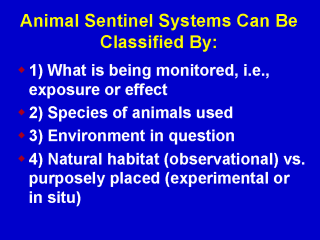|
|
|
|
front |1 |2 |3 |4 |5 |6 |7 |8 |9 |10 |11 |12 |13 |14 |15 |16 |17 |18 |19 |20 |21 |22 |23 |24 |review |
 |
1) Risk assessment involves determining the nature and magnitude of potential environmental hazards, the extent of human exposure, and the impact of such exposure on humans 2) Companion animals, food animals, fish, laboratory animals, wildlife (free ranging and captive) can all be used for sentinel systems. 3) The environments in question may be homes, workplaces, farms, aquatic ecosystems, parks, beaches, and other terrestrial ecosystems. 4) Animals can be observed in their natural habitats (eg., usual environments) or they can be deliberately placed in environments where contamination is suspected (eg., in situ) to evaluate the risk of contaminated soil, air, water, or food. |